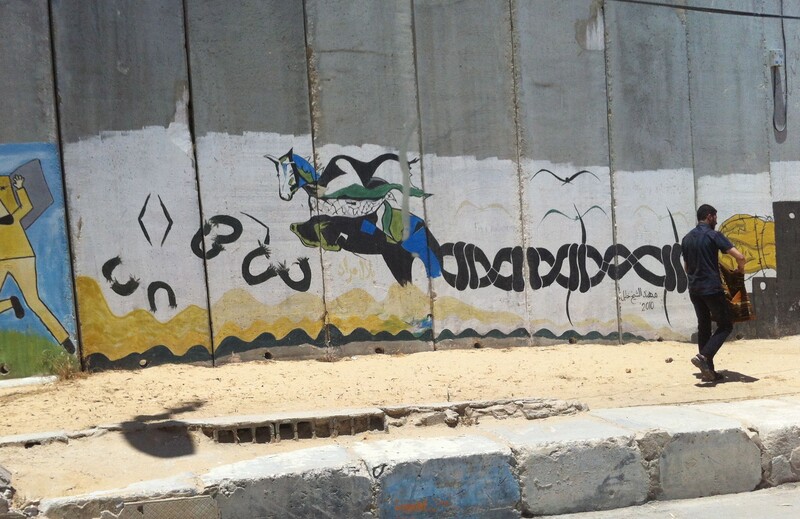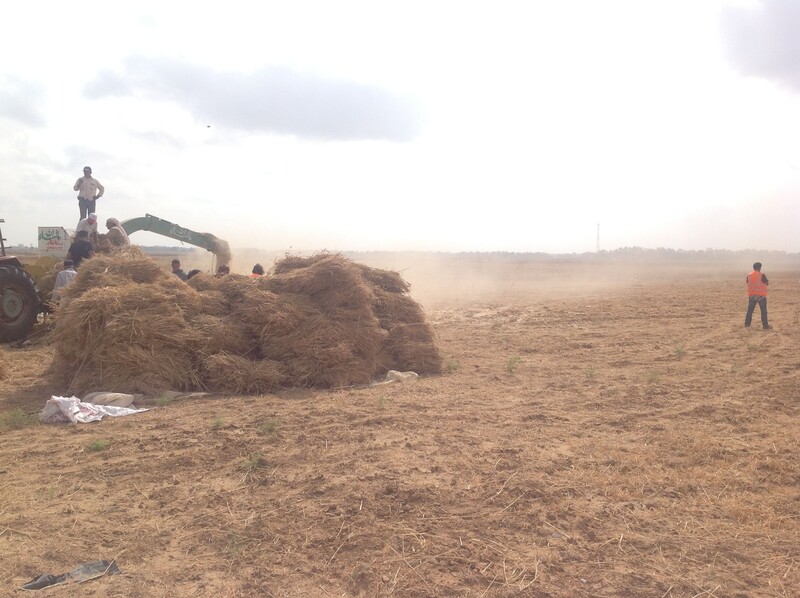30 May 2013

At Rafah, Israeli-built walls still stand between Egypt and Palestinians in Gaza.
We stood on the wooden planks of a large, circular platform, big enough to park two cars.
The operator pressed the button and a warning horn sounded. A few seconds later the platform began to descend down the deep cement-lined shaft, guided by well-engineered steel rails, cables and motors on two sides.
In less than a minute we were at the bottom of the shaft, some 30 meters below, the bright sky a mere circle high above.
The air was cool and clammy and got cooler still as we walked off the platform into the tunnel mouth which was wide enough for one car.
Reinforced every few feet with arches made from steel I-beams and lit with electric lamps, this is one of the famous tunnels that connects the Gaza Strip to Egypt.
My trip underground, a few days ago, along with other members of the Palestine Festival of Literature (palfest.org) delegation in Gaza, was coordinated for us by community members from the border city of Rafah.
“We are lions!”
Tunnel workers and security forces in the area repeatedly reminded us not to take photos every time they saw one of us reach for a mobile phone – a reasonable safety concern given that Israel has regularly bombed the tunnels, and Egypt (at the US’ behest) has variously tried to build an underground steel wall, or in the case of the current Egyptian government, deliberate flooding.
Between collapses during construction and bombing attacks, more than 240 tunnel workers have died in this area.
Before we went down the big tunnel we were shown the mouth of a smaller tunnel which had caved in during construction just two days earlier, killing 19-year-old Hamada Abu Shalouf from Rafah.
As we stood at the mouth of that tunnel, I asked one of the young workers if he didn’t get scared going underground. “Never!” he said. “We are lions!” But even a lion cannot survive being buried alive.
What could justify the price of the life of Hamada and all those sons, brothers and fathers who died before him to connect Gaza to the outside world?
Still an essential lifeline

Tunnel trade: sacks of Egyptian wheat in Gaza
According to some media reports, the tunnels might have been a necessity, but are now often depicted as money-makers so Palestinians in Gaza can import frivolities and luxuries from iPads to deliveries of KFC.
While there’s no doubt that a lot of consumer goods come through the tunnels (and why shouldn’t they?), the scope of what we saw indicates that the underground link plays a fundamental role in keeping the Gaza economy from collapse.
Tunnels operate on a large scale in an area that was once residential – thousands of homes were demolished by Israel in this area in 2003-2004 and we were not far from where Rachel Corrie was murdered.
Now, the area is full of equipment, warehouses and tunnel heads that are covered by canopies or steel sheds.
We saw impressive quantities of goods coming in, principally gravel, steel rebar, bags of cement and bricks for construction. Some tunnels bring in gasoline which is pumped through hoses then discharged into large plastic water tanks to be transported all over Gaza.
Electric winches suspended over deep shafts haul up large canvas baskets of gravel. Then workers slide the baskets sideways along an overhead rail and dump the gravel into pits below. Trucks roll down ramps into the pits to load up and take the cargo away. It is all cleverly engineered for maximum efficiency.
Other essentials coming in through the tunnels include generators to help cope with the blackouts that still leave Gaza dark for 8-12 hours per day, and the Chinese-made tuc-tucs or moto-taxis that are replacing many of Gaza’s ubiquitous donkey carts that provide transport for goods and people.
Whether all this commerce meets the needs of Gaza – with its population close to 1.7 million – is not something I can judge. There is definitely construction visible in Gaza, but nothing I would call a boom.
I also saw many workers up and down Gaza breaking rubble at bombed sites to recycle concrete and steel rebar.
This suggests that whatever is coming in from the tunnels may not meet the need, or at least not at a price people can afford. People in Gaza need to build and rebuild.
The question that struck me seeing all this is, why? Everyone knows this is going on – tunnel operations on this scale cannot be concealed.
Underground economy
Notwithstanding the gratuitous violence against tunnel workers, if Egyptian authorities wanted to shut down the tunnels completely, they know where they are, and the area they operate in is fairly limited.
So why doesn’t Egypt just let the goods in above ground? Israel’s goal has long been to separate Gaza economically, to rid itself of what it sees as a burden (although you would not know this seeing the large quantities of Israeli consumer goods on which Gaza is forced to depend – at great profit to the Israeli producers).

Israeli frozen chicken for sale at the Abu Dallal Supermarket in Nuseirat refugee camp.
Egypt ostensibly refuses to allow Israel to shift the responsibility for Gaza onto it. Palestinians too do not want to see Gaza politically and economically separated from the rest of Palestine (though they do want to see the siege and enforced dependency on Israel ended!).
And Egypt’s new Muslim Brotherhood government has continued Mubarak’s policy of acting as a US-Israel subcontractor when it comes to the Palestinians.
All this militates against the Egypt-Gaza border turning into a large-scale commercial crossing any time soon. The tunnels, it would seem, are a compromise that comes at a high price in human life: desperately-needed imports come in, sustaining the economy, but without formally legitimating or succumbing to Israel’s plan to permanently separate Gaza.
The tunnels are undoubtedly helping Gaza to survive the ongoing siege, but according to Hamdi Shaqurra of the Palestinian Centre for Human Rights (PCHR), Gaza’s private sector, the backbone of its economy, already diminished by Israeli restrictions and sanctions, is undermined even further.
“We have been moving from a formal economy to an underground economy,” Shaqurra told us during a visit to his office in Gaza City.
The long-term consequences of this may include further de-development and de-instutionalization of Gaza’s economy while placing significant parts of it into the hands of clandestine organizations on the other side of the border.
A siege on people and knowledge

As we exited Gaza on Wednesday, fellow PalFest participants, Palestinian American writer Susan Abulhawa and Egyptian journalists Lina Atallah and Nora Younis had a taste of the cruel and arbitrary reality at the Rafah crossing described by Ayah Bashir.
“More than two years after the uprising in Egypt, the Rafah crossing remains a prison gate,” Bashir writes as Palestinians must humiliatingly beg and plead to be allowed out for any purpose, and sometimes even for life-saving treatment.
Egypt makes it hardest on men under 40 who are most often sent back with no reason, a policy apparently copied from Israel which severely limits the movement of Palestinian men under 40 between Jerusalem and other parts of the occupied West Bank.
As we waited in the crowded, dirty Egyptian departure hall for a relatively modest three hours to be allowed out of Gaza, I spoke to several Palestinian men who waited nervously, not knowing if they would be let out by the unreformed Mubarak-era security apparatus.
One young man, a student in Germany, had been visiting Gaza because his mother had suffered a stroke. He told me he always left Gaza at least 72 hours before his flight from Cairo, not knowing how long he would be kept at the border. On one visit, he slept at the crossing for two weeks.
Now I can understand better the words of Sameeha Elwan, one of our hosts, who wrote after our departure:
We bid farewell to Susan, Ali, Lina and Nora yesterday after four days of Palfest (Palestine Festival of Literature) events in Gaza. But even after they left, I can still inhale the air of euphoria that accompanied their presence filling the space. During their stay, an air of easiness prevailed, and those internal feelings of entrapment, of imprisonment, of siege, which troubles the feigned normalcy of our everyday life, were suddenly suspended. Gaza was no longer the bearer of borders, the enclaved concentration camp, or the inevitability of death and life. We transcended that through imagination; or maybe I did.
I only wish that Susan, Lina, Nora and myself really did have the ability to change those realities just by spending a few days in Gaza, yet Sameeha’s poignant words reflect those we heard from many others.
We heard of the anxiety of students who have studied so hard but see an iron ceiling holding down their ambitions and prospects. We heard it from writers, media-makers and activists who participated in Palfest workshops.
We heard it from academics, including Dr. Walid Amer, the Dean of the Faculty of Arts at the Islamic University of Gaza, who spoke of the persistent difficulty obtaining books, research materials and supplies for the university’s 23,000 students and the entire education sector. It is also impossible for academics to engage in any sort of regular travel for research or conferences.
We heard it from the educators at the Rachel Corrie Cultural Centre in Rafah regugee camp with whom we played a game of musical chairs.
We, the visitors, played the role of Gazans, and they played the besiegers.
But the game was rigged: the besiegers sat on the chairs before the music stopped – sometimes before it even started – or pulled the chairs out from under us if we managed to sit down. They blocked our way until finally we gave up.
And they told us that for all the people who do stay steadfast and insist on living their lives, some young people in Gaza do give up, and turn to abusing the pain reliever Tramadol to numb the agony of a hopeless routine.
The fact that a visit like ours that ought to be so ordinary, to pass without notice, was so extraordinary in Sameeha Elwan’s eyes, is a measure of how much isolation people in Gaza are enduring.
I hear Sameeha’s words as a call on all of us outside Gaza to intensify our solidarity work with those under siege.
Isolated from the rest of Palestine
After 1967, when Israel occupied the West Bank and Gaza Strip (along with the Syrian Golan Heights and Egypt’s Sinai), present-day Israel, the West Bank and Gaza Strip functioned to a large extent as a single territory. Though lacking basic rights, Palestinians could still travel and work throughout historic Palestine.
“One of the undesired effects of occupation from Israel’s perspective,” according to PCHR’s Hamdi Shaqurra, “is that it strengthened Palestinian identity and unity under occupation.”
From the early 1990s, Israel began to gradually separate Palestinians from eachother, a process that accelerated after the 1993 Oslo Accords, and then again using the pretext of security.
Before 1990, approximately 40 percent of students in West Bank universities were from Gaza. Today the number is effectively zero. “Israel is pushing Gaza toward a separate identity,” Shaqurra said.
It is indeed striking how rare it is to meet a young Palestinian in Gaza who has seen any other part of Palestine. When Shahd Abusalama did reach Jerusalem and Jaffa last year for a few hours, she wrote that it “felt like a dream, one so happy that I never wanted to wake up.”
For most Palestinians in Gaza it is a dream, as seemingly unttainable as reaching the moon.
After my visit, I can understand better Palfest Gaza organizer Rana Baker’s recent piece on her own struggle to make sense of and maintain her Palestinian identity in Gaza.
Gaza as warning and hope

Farmers harvest wheat at Khuza’a on the eastern edge of Gaza as a Spanish solidarity worker in orange vest faces toward an Israeli watchtower from which soldiers frequently open fire.
When we asked Shaqurra to evaluate the human rights situation in Gaza since last November’s Israeli attack, he observed that things had almost returned to the pre-war status quo: Israel is enjoying a truce that is scrupulously observed by the Palestinian side, while the siege remains intact and Israel pays no political price.
Instead of “easing” the closure, as has been repeteadly promised, it has just become institutionalized with the consent and legitimation of the UN, the European Union and other international bodies.
Everywhere that Israel rules Palestinians, it has successfully reduced them to worrying about daily life – the next meal, the next payment, the next permit – too preoccupied, too hungry, mentally even more than physically, to mount a successful resistance.
All of this is buying Israel the peace and quiet it needs to pursue the project that is really important to 21st Century Zionism: completing the colonization of the West Bank. And when that’s done?
“What I am afraid of is that sooner or later the Israeli leadership will do to parts of the West Bank what it has done to Gaza,” Shaqurra said.
Take for example the city of Qalqilya. “It is surrounded by a wall, just like Gaza,” Shaqurra noted. “Israel could declare Qalqilya a separate zone and say, ‘We don’t care who runs Qalqilya as long as Qalqilya observes the same rules of the game as Gaza.’”
All of this would be presented – just like Israel’s 2005 so-called “disengagement” from Gaza – as the merciful act of a liberal Israeli nation which claims “we do not want to be occupiers.” But the catastrophe for Palestinians of fractured geography and identity would worsen.
I know all of this and yet I did not come away from Gaza depressed or hopeless. The feeling I came away with is that for all the hardships they face, people in Gaza have not surrendered and won’t surrender any time soon.
Rather, the worry I heard from more than one person in Gaza is that the rest of the Palestinian people might forget about them, or give up first.
All photos by Ali Abunimah.





Comments
Gaza
Permalink Joyce Guinn replied on
What a great article. I was in Gaza with the Interfaith Peace Builders as the Nov. bombing began. It was my first trip to Gaza after four to the West Bank. I couldn't believe the resilience of the people and there warmth towards us. I felt completely safe. What a privilege it was to be with these brave people. I plan to return soon!
Great article. Gives a good
Permalink Kath Hudson replied on
Great article. Gives a good idea of what it's like on the inside.
That Gaza and the West Bank
Permalink Anonymous replied on
That Gaza and the West Bank grow more apart can not be solely blamed on Israel. Hamas and Fatah have been failing for years now to reconcile.